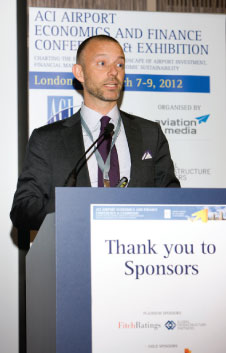
ACI EUROPE Director General Olivier Jankovec indicated that while the EU is going through tough economic times, passenger traffic outperformed economic growth by 4 times in 2011, growing by +6.3% compared with +1.5%. Image © Aviation Media
When the advent of airport competition is discussed, it is often in terms of improved service quality, competitive pricing and innovative products. But there is a separate entire area of expertise which this development has spawned – an expertise which often goes unnoticed but which is fundamental to the functioning of our
dynamic industry.
Enter the airport economist and financier. Including airport CEOs, CFOs, investors, regulators and academics, these individuals deal with a multitude of different issues, from privatisations, to airport acquisitions, Public-Private Partnerships (PPPs) and capital expenditure financing. At its most basic, they ensure that funding is available to keep airports operating and expanding as and when required. The discipline is also truly a global one, with PPP deals in Brazil and airport regulation in India stimulating much of
the debate and discussion within the conference.
Simultaneously airports are now harnessing these economic skills internally, to benchmark and improve operational performance, and to gain deep insights into the needs of their passengers.
Industry Insight
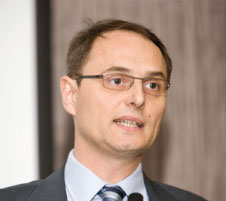
Nicolas Painvin, Head of Infrastructure EMEA, Fitch Ratings, added that “generally speaking, airports are a quite resilient asset class”. “A key macro-economic factor is the fuel price. It’s now about 35% of the revenue per seat mile in the case of most airlines. We believe oil prices will be high for some time.” Image © Aviation Media
Of course while issues such as privatisation and PPPs may be relatively new elements within the industry, all decisions are still based very much upon an intimate knowledge of the airport business and wider industry trends. With this in mind, conference delegates were treated to opening remarks from the Director Generals of ACI WORLD and ACI EUROPE respectively, and addresses from heads of key airports and airport groups from Europe and beyond.
Angela Gittens, Director General ACI WORLD, opened with some global traffic statistics for 2011, which portrayed a mixed picture. Negative Cargo growth – often a precursor of things to come in the passenger market – led ACI WORLD’s growth estimates for passenger traffic in 2012 to be revised down from +5% to +3.9%. More encouragingly, Gittens noted that “Between 2011 and 2015, 7 of the top 10 growth countries will be African” and reminded delegates that the infrastructure will have to be in place to support this growth.
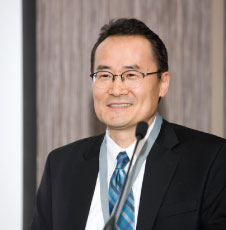
Kwan Young Chung, Vice President, SAMSUNG C&T, participated on the airport investors panel. He explained that SAMSUNG’s investment considerations include market potential, government policy, integrated business opportunities, risk management and efficient programme management. Image © Aviation Media
Focusing on Europe, ACI EUROPE Director General Olivier Jankovec indicated that while the EU is going through tough economic times, passenger traffic outperformed economic growth by 4 times, growing by +6.3% compared with +1.5%. “There is a contrasting picture between the EU and ‘new Europe’ led by Russia and Turkey, where there is strong growth,” commented Jankovec. Indeed, passenger traffic increased by +11.8% in ‘new Europe’ in 2011, while GDP rose by +5.1%. Moving beyond traffic, Jankovec spoke about some of the wider trends within the industry, in particular outlining the risk sharing which now exists between airports and airlines. “In recent years, airports have changed the structure of their charges, putting more weight on passenger related charges,” he explained.
Mention was also made of equally worrying developments, which threaten to undermine the financial sustainability of the industry. “We are facing challenges to commercial revenues. Some airlines are applying restrictive one bag policies, which are hurting some regional airports. There is also the looming threat of a ban on duty free sales of liquor and tobacco, which is being debated at the World Health Organization,” commented Jankovec.
Airport Leadership Insight
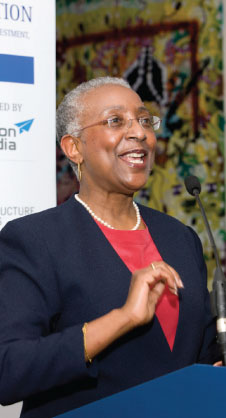
Angela Gittens Director General ACI WORLD, opened with some global traffic statistics for 2011, which portrayed a mixed picture. Image © Aviation Media
Colin Matthews, CEO of BAA, spoke about the importance of aviation to economic growth. In the UK, the debate regarding the importance of an effective hub airport has widened and business people are arguing that it matters that they can travel to their customer markets. “We describe London-Heathrow’s job as being to provide the maximum number of connections possible to enable UK business to thrive and trade,” Matthews asserted. “What is difficult to get across to the public is that, in order to make long haul destinations viable, we have to win tough competition for transfer traffic.” BAA is investing significantly to secure London-Heathrow’s competitive position – to the tune of £100 million (€120m) every month.
Dr Yiannis Paraschis, CEO, Athens International Airport and Chair, ACI WORLD, spoke about the airport’s Public-Private Partnership (PPP) and in particular highlighted the impact of the current economic troubles. “We have experienced, in our case, that extending or modifying concession terms or PPPs is a very difficult exercise,” he said. “Despite a -6.3% drop in traffic in 2011 in an unstable market, we will still distribute a dividend to shareholders of €111 million – that looks like a good investment for public and private shareholders.”
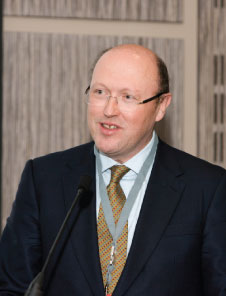
Michael McGhee, Partner in Global Infrastructure Partners (GIP) said the company’s strategy is focused on a long-term horizon. “We like large investments and we must have a controlling stake, as our whole investment mandate is about improvement. We obviously look at growth outlook and also improvement potential.” Image © Aviation Media
Dr Waleed Youssef, Chief Strategy Officer, offered the TAV Airports Holding view on airport investment. TAV Airports has entered into a contract for the acquisition of 38% of its issued share capital by Aéroports de Paris, and Dr. Youssef said “We’re at a very exciting time at TAV Airports.” He speaks with no small amount of experience. Now 11 years old, TAV Airports operates a portfolio of 10 airports with an annual throughput of 53 million passengers. Significantly, a consortium led by TAV Airports has signed a Build Transfer Operate contract with GACA, the Civil Aviation Authority of Saudi Arabia, for Medina Airport – the first airport privatisation in Saudi Arabia. Dr. Youssef explained that an investment of approximately $1 billion (€760m) to $1.5 billion (€1.14bn) is expected, with the consortium to construct a state-of-the-art passenger terminal in the first half of 2015 and operate Medina Airport for 25 years.
General Manager of ICF Antalya Airport, Alexander-Sven Laukenmann shared his own views on the privatisation of the airport.
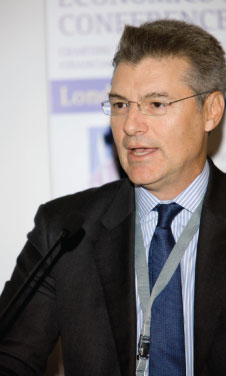
Dr Yiannis Paraschis, CEO, Athens International Airport and Chair, ACI WORLD, spoke about the airport’s Public-Private Partnership (PPP) and in particular highlighted the impact of the current economic troubles. Image © Aviation Media
The airport – winner of the ACI EUROPE Best Airport Award in the 10-25 million passengers category in 2011 – is a hugely successful example of a privatisation project. In April 2007, a consortium of Fraport and IC Ictas Holding secured the tender to operate all three terminals at the airport, with a total concession payment amounting to €2.37 billion – it was the largest privatisation project in the aviation sector in Turkey. Reflecting on the deal, Laukenmann noted that the financing strategy was and continues to be based on “strong investors with competing strengths and aggressive financing with sensible lenders”.
Miriam Ryan, Head of Strategy at Dublin Airport Authority (DAA), took a different tack, speaking about how economics skills can be applied strategically within an airport. In particular conference delegates learnt just how integral Key Performance Indicators are to performance management within DAA. Strategic core objectives for the business are defined and these are then extrapolated and cascaded down through the organisation, ensuring that management across the company are working together to meet the same ends. This approach is very much reliant upon Key Performance Indicators, which provide both targets to aim for, as well as allowing subsequent assessment of performance. Emphasising the dynamic nature of the process, Ryan pressed upon delegates that objectives and performance measures must be continually reviewed and reevaluated, to ensure the business as a whole continues to operate in the right way, and towards the right goals.
The Bankers
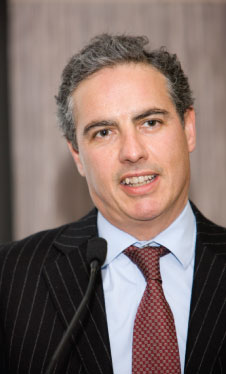
Arturo Recio, Global Head of Infrastructure, Global Banking, HSBC, indicated that the 2012 outlook still bears significant uncertainties. “As a firm, we are great believers in emerging markets – they are where growth will come from,” he asserted. Image © Aviation Media
Widening its scope, the conference also gained the perspective of external investors, who are now deeply engaged in all facets of the airport industry.
Michael McGhee, Partner in Global Infrastructure Partners (GIP) said the company’s strategy is focused on a long-term horizon. GIP acquired London City Airport in 2006 and London-Gatwick in 2009. “We like large investments and we must have a controlling stake, as our whole investment mandate is about improvement,” he commented. “We obviously look at growth outlook and also improvement potential.”
Nicolas Painvin, Head of Infrastructure EMEA, Fitch Ratings, added that “generally speaking, airports are a quite resilient asset class”. “A key macro-economic factor is the fuel price. It’s now about 35% of the revenue per seat mile in the case of most airlines. We believe oil prices will be high for some time,” he said.
With input from such a wide variety of industry players, and over 200 delegates in attendance, the conference successfully addressed the key economic and financial trends impacting airports, as well as possible responses to these developments. In particular the event highlighted that air transport has become fundamental to social and economic development, but that challenges remain which must be addressed not only by the industry and its partners, but also by the wider regulatory framework.







